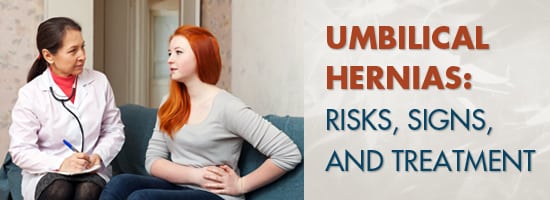Umbilical Hernias: Risks, Signs, and Treatment

An umbilical hernia is when the lining of the stomach begins to protrude outward around the navel. It can be the result of many different things and is more common in children, especially newborn babies. The hernia typically does not cause pain for children, but can be painful for adults. Although an umbilical hernia is generally harmless and will go away on its own, it is important to have a doctor monitor the hernia to ensure that it is not progressing or causing further problems. There are many risk factors that give some individuals a higher change of having a hernia, but they are generally able to be treated easily.
Who is more at risk for a hernia?
Babies who are born prematurely show a higher instance of umbilical hernias at birth. Additionally, women who carry multiple babies at one time have more umbilical hernias than those who do not and individuals who are obese are also at an increased risk.
Umbilical hernias can also begin showing up after a long period of coughing or vomiting. While coughing and vomiting does not necessarily cause a hernia, it can cause one to become more prominent.
What are the signs of an umbilical hernia?
The first and most common sign of an umbilical hernia is bulging of the stomach. The stomach will protrude out around the belly button area and can feel like a hard knot or a soft lump. If an umbilical hernia is present, the bulge will appear bigger when a person laughs, coughs, or strains in any way. Umbilical hernias rarely cause pain for children and babies, but adults may feel pain ranging from mild to severe in the area that the hernia is protruding.
When should I seek treatment?
It is a good idea to seek treatment any time that you think a hernia might be ailing you or your child. They are generally harmless, but can lead to problems such as intestinal blockage. Umbilical hernias in infants will generally go away on their own after 12 months without need for any additional treatment. Older children and adults who are experiencing umbilical hernias are usually recommended to have surgery to prevent further complications. The surgery that is performed is minimally invasive with a short healing period.
If you believe that you or your child might have any of the symptoms of an umbilical hernia, it is important to check with your doctor. A hernia can be determined by a quick physical examination, and your doctor can help you determine the best course of action.


